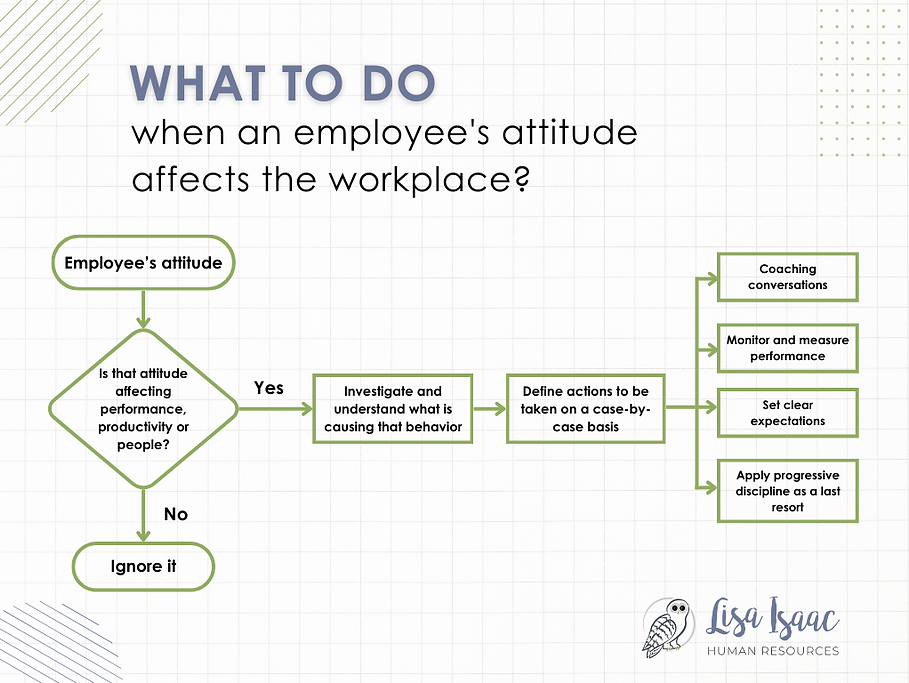
Is Someone's "Attitude" Enough Reason to "Fire" Them?

A common question that I receive from employers is whether an employee with a “bad attitude” can be terminated for cause. The short answer is no. The real question is whether or not the attitude is compromising the processes, productivity, performance, and overall well-being of the workplace, and what you, as a leader, can do about it.
We hire people for their knowledge, skills, and abilities, and although attitude influences how one fits into a team or workplace, you need to ask yourself if it is the most important thing about the job. In an ideal world, everyone on the team would have the “right” attitude and complete all assigned tasks the way we want them to be done - on time and within budget. But does the Gossipy Gus, the Negative Nelly, the Bland Blake, or the Distracted Dylan really harm your business, or create a reason for performance management?
1. Ask yourself if it is affecting the workplace: Performance, Productivity, People
We all have different personalities, communication styles, and approaches to life and work, and this contributes to creativity, innovation, and a generally more interesting environment. Without people who see a challenge from a different perspective, we would not have many of the advancements in society or technology we enjoy today. Diversity in all forms, including attitude, can lead to success.
Just because an employee doesn’t smile every time you walk by, does not mean that they do not provide excellent customer service to your clients – it could just be that you walked by when they were performing a calculation or resolving an unplanned production issue and didn’t think to smile. Remember, smiling is also not a requirement of most jobs, nor is it common as a sign of a “good attitude” in every culture. But sometimes, an attitude can get in the way of progress, particularly if it involves being rude to coworkers or customers, hiding mistakes, hindering the performance of others, or flat-out refusing to perform tasks that make up the job’s core.
To determine if the bad attitude is an actual performance problem, you need to assess, without bias, its impact on employee and team performance, the productivity of the workplace, and the impact on the people in your business. If the attitude, or behaviours that result from the attitude, does not impact performance, productivity, or people, then it is possible to just ignore it.
If an employee’s attitude is impacting the productivity or performance of their role or that of their co-workers, then it is a problem and needs to be addressed the same way that any other work-related issue would be – through an open and honest conversation with the employee.
2. Investigate the cause of the behavior
Think of this as a fact-finding mission and an opportunity for understanding. Bring your concern, with specific, fact-based examples, to the employee. Ask them about what occurred and why. When you frame this conversation out of concern for the employee’s situation and success, using one of the coaching methods we have previously discussed, and not in an accusatory or punitive way, the employee may share the cause/effect of the attitude with you.
Common employee concerns include distractions from outside of work, frustrations with the job such as tasks or technology, fairness with pay or rewards, or relationships with other team members. Understanding what feeds into an employee’s attitude, and what you can do to help, is the first step to ensuring that the workplace is productive and healthy.
I once worked with a friendly employee who suddenly changed their communications to brief, concise statements that bordered upon rude. Coworkers noticed this change and brought it to my attention out of concern. During a conversation with the employee about this noticeable difference in behaviour, it came out that they were suffering from excessive pain and required hip surgery. The employee didn’t feel they had the paid time off available for the procedure and recovery. Working together we found a solution, and they were able to return to work pain-free and back to their friendly demeanour.
Remember, issues that you may experience relating to an employee refusing overtime, not completing certain tasks, not volunteering for business trips, or not following procedures could be related to childcare concerns, lack of training, safety concerns, or a different approach to a task than the one you are used to, and you won’t know until you ask.
3. What can you do about it?
Not every concern may be easily addressed through a single conversation, and sometimes, even with coaching, an employee will not modify their attitude or behaviour. In these situations, it is crucial to lay out clear expectations of what the employee must do in their job, monitor and measure their performance, and provide regular and ongoing feedback on where they are or are not meeting the expectations. If an employee must follow a standard operating procedure, make sure they understand that, know why, and are adequately trained on how to do it, and explain how and when this will be measured and monitored. A majority of the time coaching will resolve the problem, but if not, you can learn more about progressive discipline here.
Do you find it challenging to gauge your employees' engagement levels? LIHR facilitates engagement surveys that measure employees' psychological health and safety and identify areas of concern to help improve engagement, inclusion, and safety—including recognition and motivation. Book time with us to learn how we can help you engage, motivate, and reward employees.

From the LIHR team and lead collaborator, Rebecca Wilkinson, Senior HR Consultant Rebecca@LisaIsaacHR.com
Lisa Isaac HR Professional Services
Book a meeting with Lisa here
Blog Photo by Cyrus Chew on Unsplash

